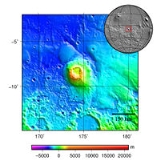
Apollinaris Patera
Encyclopedia
.jpg)
Shield volcano
A shield volcano is a type of volcano usually built almost entirely of fluid lava flows. They are named for their large size and low profile, resembling a warrior's shield. This is caused by the highly fluid lava they erupt, which travels farther than lava erupted from more explosive volcanoes...
on Mars's
Mars
Mars is the fourth planet from the Sun in the Solar System. The planet is named after the Roman god of war, Mars. It is often described as the "Red Planet", as the iron oxide prevalent on its surface gives it a reddish appearance...
surface. It is situated near the equator
Equator
An equator is the intersection of a sphere's surface with the plane perpendicular to the sphere's axis of rotation and containing the sphere's center of mass....
in the south hemisphere, southeast of the shield volcano Elysium Mons
Elysium Mons
Elysium Mons is a volcano on Mars located in the Elysium Planitia, at , in the Martian eastern hemisphere. It stands about 13.9 km above the surrounding lava plains, and about 16 km above the Martian datum. Its diameter is about 240 km, with a summit caldera about 14 km across...
on the Elysium Planitia
Elysium Planitia
Elysium Planitia is the second largest volcanic region on Mars, after Tharsis Montes. It is centered at . It includes volcanoes, from north to south, Hecates Tholus, Elysium Mons and Albor Tholus. Another large volcano, Apollinaris Mons, lies south of the others. Besides having large volcanoes,...
, and north of Gusev crater
Gusev crater
Gusev is a crater on the planet Mars and is located at . The crater is about 166 kilometers in diameter and formed approximately three to four billion years ago. It was named after Russian astronomer Matvei Gusev in 1976....
. The volcano's crater
Volcanic crater
A volcanic crater is a circular depression in the ground caused by volcanic activity. It is typically a basin, circular in form within which occurs a vent from which magma erupts as gases, lava, and ejecta. A crater can be of large dimensions, and sometimes of great depth...
is named Apollinaris Patera; this name formerly applied to the whole edifice.
Apollinaris Mons is about 5 kilometres high with a base about 296 kilometres in diameter. On the top of this volcano is a small crater with an irregular border, which was probably made by an explosive, or pyroclastic, eruption. The volcano is approximately 3 billion years old or possibly 3.5 billion years old.
It was named in 1973 after a mountain spring near Rome
Rome
Rome is the capital of Italy and the country's largest and most populated city and comune, with over 2.7 million residents in . The city is located in the central-western portion of the Italian Peninsula, on the Tiber River within the Lazio region of Italy.Rome's history spans two and a half...
in Italy
Italy
Italy , officially the Italian Republic languages]] under the European Charter for Regional or Minority Languages. In each of these, Italy's official name is as follows:;;;;;;;;), is a unitary parliamentary republic in South-Central Europe. To the north it borders France, Switzerland, Austria and...
.

